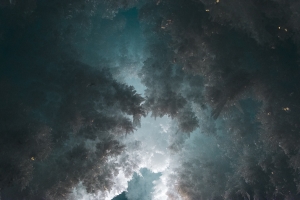What is the exhibit?
Kyoko Kinoshita
Goucher College is holding an exhibition entitled “Walking in Antarctica” by Helen Glazer in Rosenberg Gallery, from October 18th to December 18th. Helen Glazer makes photographs and photo-based sculptures based on complex natural forms, informed by an understanding of scientific concepts of growth and form in nature.
This is exhibition is of her seven week “walks”: over frozen lakes, into frozen ice caves, up mountains and with the Adélie penguins. The gallery is structured so that you follow her journey as you walk along the wall. As soon as you enter the main entrance, you will see the audio guide and brochure right in front of you.

Background on the Artist
Guadalupe Sosa
Helen Glazer comes from a well-established art background. Her art career began during her undergraduate years. She obtained a Bachelor’s Degree in Art from Yale University. Afterwards, she went on to the Maryland Institute College of Art to obtain her Masters in painting. Not only is Glazer’s work displayed at Goucher College, but two pieces from her Walking in Antarctica exhibit will be displayed at the BWI airport.
Art and Technology
Virginia Turpin
Helen Glazer created this exhibit after spending seven weeks in 2015 in Antarctica on a grant from the National Science Foundation’s Antarctic Artists and Writers Program. She spent this time photographing the landscape as well as mapping rock formations for sculpture using photogrammetry and 3D printing.
Despite the technology woven through the exhibit, the focus Glazer brings to the wild and natural beauty of Antarctica makes it feel earthy, rather than high tech. Throughout the exhibit she seeks to illustrate the different landscapes and features present in Antarctica beyond the stereotypical imaginings of Antarctica as endless snow desert. She does this by showing the close details of frost and snow, as well as alien underground chambers. She takes the viewer through the more rocky aspects of the coldest continent, including rocks bare of snow and icy mountain-scapes, as well as low lying lakes and muddy patches. Last, but certainly not least, she does not neglect Antarctica’s most photogenic resident: the penguin.
Why You Should Go
Kyoko Kinoshita
This exhibition was beautiful and educational. Antarctica is very far away and there is not much opportunity to learn about it in daily life, so it was very nice to see pictures from there and to learn about Antarctica, especially now, when the global warming is a huge issue.
Pondering about the Future
Guadalupe Sosa
I believe the theme of this exhibit would be pondering about the future. These pictures make you look beyond the focal point. Glazer may be making a point to look forward to the other side. This exhibit hit me because, as a senior in college, I am scared to look into the future. I am at crossroads in my career: should I stay at my current job or go elsewhere? I feel connected with the small penguin. The penguin is an equivalent parallel to my pondering in life. Overall, Glazer did an incredible job of fusing Antarctica’s with a deep message of finding oneself.
From a Photographic Point of View
Sara Naughton
Focusing more on the photographs for this exhibit, you can tell she structured her photos differently according to the different subject she chose. I liked that she decided to have a wider camera view of the landscapes, giving the viewer a broader glance into the environment, whereas when she photographed the subject matter of ice formations, she had a very close up view of them, which gives an entirely different perspective. This allows you to see intricate details you would otherwise miss, and look at ice entirely differently. Sometimes things that are photographed up close look like entirely different things.
Artistic Rather than Environmental
Miranda Egan Brooks
Although its aim was to shed light on Antarctica’s need for environmental concern, Glazer’s exhibition does not quite accomplish this and is stronger in other areas. Glazer’s success comes from her artistic talents and ability to depict the richness of the Antarctic landscape. Since each picture was so full of interesting content, I found myself focusing on the visual pleasures and complexities of the work, rather than feeling any concern for Antarctica’s environment. I can say that I genuinely appreciated a great number of Glazer’s photographs and that I left the exhibition appreciative of Glazer’s ability to expand my knowledge of the Antarctic landscape in a creative and impacting way.
Art Analysis: Blue Fractals
Miranda Egan Brooks
Packed with emotions, aesthetically intriguing, and demonstrative of technical skills, Blue Fractals is one of my favorite pieces in Glazer’s collection. I especially enjoy how much this photo has to offer in regards to content and perspective. The balance between light and dark subjects creates a simultaneous sensation of restriction and expansion, of being consumed and being freed. This photograph is also remarkable, as it illustrates the intricacies and beauty of nature in a very graceful way.
Intrigued? Check out the exhibit for yourself in the Rosenberg Gallery.
